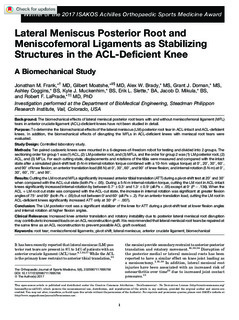| dc.contributor.author | Frank, Jonathan M. | |
| dc.contributor.author | Moatshe, Gilbert | |
| dc.contributor.author | Brady, Alex W. | |
| dc.contributor.author | Dornan, Grant J. | |
| dc.contributor.author | Coggins, Ashley | |
| dc.contributor.author | Muckenhirn, Kyle J. | |
| dc.contributor.author | Slette, Erik L. | |
| dc.contributor.author | Mikula, Jacob D. | |
| dc.contributor.author | LaPrade, Robert F. | |
| dc.date.accessioned | 2018-04-20T09:24:55Z | |
| dc.date.available | 2018-04-20T09:24:55Z | |
| dc.date.created | 2017-10-07T17:20:03Z | |
| dc.date.issued | 2017 | |
| dc.identifier.citation | The Orthopaedic Journal of Sports Medicine. 2017, 5, 2325967117695756. | nb_NO |
| dc.identifier.issn | 2325-9671 | |
| dc.identifier.uri | http://hdl.handle.net/11250/2495250 | |
| dc.description | This open-access article is published and distributed under the Creative Commons Attribution - NonCommercial - No Derivatives License (http://creativecommons.org/licenses/by-nc-nd/3.0/), which permits the noncommercial use, distribution, and reproduction of the article in any medium, provided the original author and source are credited. You may not alter, transform, or build upon this article without the permission of the Author(s). For reprints and permission queries, please visit SAGE’s website at http://www.sagepub.com/journalsPermissions.nav. | nb_NO |
| dc.description.abstract | Background: The biomechanical effects of lateral meniscal posterior root tears with and without meniscofemoral ligament (MFL) tears in anterior cruciate ligament (ACL)–deficient knees have not been studied in detail. Purpose: To determine the biomechanical effects of the lateral meniscus (LM) posterior root tear in ACL-intact and ACL-deficient knees. In addition, the biomechanical effects of disrupting the MFLs in ACL-deficient knees with meniscal root tears were evaluated. Study Design: Controlled laboratory study. Methods: Ten paired cadaveric knees were mounted in a 6-degrees-of-freedom robot for testing and divided into 2 groups. The sectioning order for group 1 was (1) ACL, (2) LM posterior root, and (3) MFLs, and the order for group 2 was (1) LM posterior root, (2) ACL, and (3) MFLs. For each cutting state, displacements and rotations of the tibia were measured and compared with the intact state after a simulated pivot-shift test (5-Nm internal rotation torque combined with a 10-Nm valgus torque) at 0, 20, 30, 60, and 90 of knee flexion; an anterior translation load (88 N) at 0, 30, 60, and 90 of knee flexion; and internal rotation (5 Nm) at 0, 30, 60, 75, and 90. Results: Cutting the LM root and MFLs significantly increased anterior tibial translation (ATT) during a pivot-shift test at 20 and 30 when compared with the ACL-cut state (both Ps < .05). During a 5-Nm internal rotation torque, cutting the LM root in ACL-intact
knees significantly increased internal rotation by between 0.7 ± 0.3 and 1.3 ± 0.9 (all Ps < .05) except at 0 (P ¼ .136). When the ACL þ LM root cut state was compared with the ACL-cut state, the increase in internal rotation was significant at greater flexion angles of 75 and 90 (both Ps < .05) but not between 0 and 60 (all Ps > .2). For an anterior translation load, cutting the LM root in ACL-deficient knees significantly increased ATT only at 30 (P ¼ .007). Conclusion: The LM posterior root was a significant stabilizer of the knee for ATT during a pivot-shift test at lower flexion angles and internal rotation at higher flexion angles. Clinical Relevance: Increased knee anterior translation and rotatory instability due to posterior lateral meniscal root disruption may contribute to increased loads on an ACL reconstruction graft. It is recommended that lateral meniscal root tears be repaired at the same time as an ACL reconstruction to prevent possible ACL graft overload. | nb_NO |
| dc.language.iso | eng | nb_NO |
| dc.subject | root tear | nb_NO |
| dc.subject | meniscofemoral ligaments | nb_NO |
| dc.subject | pivot shift | nb_NO |
| dc.subject | lateral meniscus | nb_NO |
| dc.subject | anterior cruciate ligament | nb_NO |
| dc.subject | biomechanical | nb_NO |
| dc.title | Lateral meniscus posterior root and meniscofemoral ligaments as stabilizing structures in the ACL-deficient knee: a biomechanical study | nb_NO |
| dc.type | Journal article | nb_NO |
| dc.type | Peer reviewed | nb_NO |
| dc.description.version | publishedVersion | nb_NO |
| dc.rights.holder | © The Author(s) 2017 | nb_NO |
| dc.source.pagenumber | 2325967117695756 | nb_NO |
| dc.source.volume | 5 | nb_NO |
| dc.source.journal | The Orthopaedic Journal of Sports Medicine | nb_NO |
| dc.source.issue | 6 | nb_NO |
| dc.identifier.doi | 10.1177/2325967117695756 | |
| dc.identifier.cristin | 1503012 | |
| dc.description.localcode | Seksjon for idrettsmedisinske fag / Department of Sport Medicine | nb_NO |
| cristin.unitcode | 150,34,0,0 | |
| cristin.unitname | Seksjon for idrettsmedisinske fag | |
| cristin.ispublished | true | |
| cristin.fulltext | original | |
| cristin.qualitycode | 1 | |
